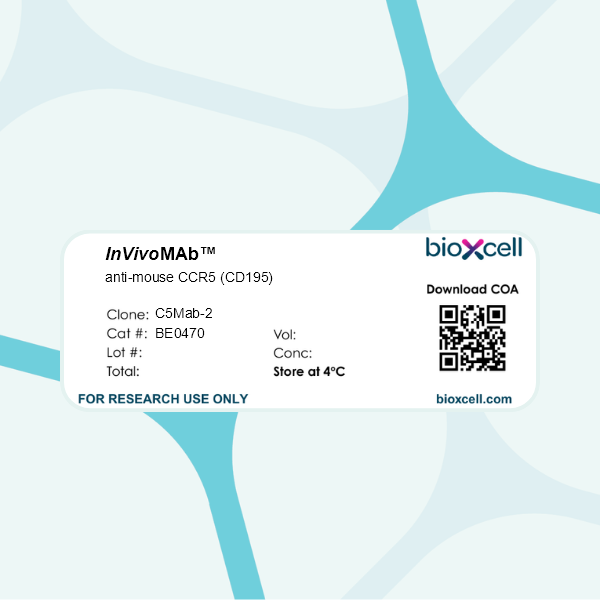InVivoMAb anti-mouse CCR5 (CD195)
Product Description
Specifications
| Isotype | Rat IgG2b, κ |
|---|---|
| Recommended Isotype Control(s) | InVivoMAb rat IgG2b isotype control, anti-keyhole limpet hemocyanin |
| Recommended Dilution Buffer | InVivoPure pH 7.0 Dilution Buffer |
| Immunogen | Mouse CCR5 expressing CHO-K1 cells |
| Reported Applications |
Flow cytometry For details on in vivo applications, please contact technicalservice@bioxcell.com |
| Formulation |
PBS, pH 7.0 Contains no stabilizers or preservatives |
| Endotoxin |
≤1EU/mg (≤0.001EU/μg) Determined by LAL assay |
| Purity |
≥95% Determined by SDS-PAGE |
| Sterility | 0.2 µm filtration |
| Production | Purified from cell culture supernatant in an animal-free facility |
| Purification | Protein G |
| Molecular Weight | 150 kDa |
| Storage | The antibody solution should be stored at the stock concentration at 4°C. Do not freeze. |
| Need a Custom Formulation? | See All Antibody Customization Options |
Application References
Flow Cytometry
Ubukata R, Suzuki H, Tanaka T, Li G, Kaneko MK, Kato Y (2024). "Development of Sensitive Anti-Mouse CCR5 Monoclonal Antibodies Using the N-Terminal Peptide Immunization" Monoclon Antib Immunodiagn Immunother 43(4):112-118.
PubMed
One of the G protein-coupled receptors, C-C chemokine receptor 5 (CCR5), is an important regulator for the activation of T and B lymphocytes, dendritic cells, natural killer cells, and macrophages. Upon binding to its ligands, CCR5 activates downstream signaling, which is an important regulator in the innate and adaptive immune response through the promotion of lymphocyte migration and the secretion of proinflammatory cytokines. Anti-CCR5 monoclonal antibodies (mAbs) have been developed and evaluated in clinical trials for tumors and inflammatory diseases. In this study, we developed novel mAbs for mouse CCR5 (mCCR5) using the N-terminal peptide immunization. Among the established anti-mCCR5 mAbs, C5Mab-4 (rat IgG2a, kappa) and C5Mab-8 (rat IgG1, kappa), recognized mCCR5-overexpressing Chinese hamster ovary-K1 (CHO/mCCR5) and an endogenously mCCR5-expressing cell line (L1210) by flow cytometry. The dissociation constant (KD) values of C5Mab-4 and C5Mab-8 for CHO/mCCR5 were determined as 3.5 × 10-8 M and 7.3 × 10-9 M, respectively. Furthermore, both C5Mab-4 and C5Mab-8 could detect mCCR5 by western blotting. These results indicated that C5Mab-4 and C5Mab-8 are useful for detecting mCCR5 by flow cytometry and western blotting and provide a possibility to obtain the proof of concept in preclinical studies.
Flow Cytometry
Suzuki H, Tanaka T, Li G, Ouchida T, Kaneko MK, Kato Y (2024). "Development of a Sensitive Anti-Mouse CCR5 Monoclonal Antibody for Flow Cytometry" Monoclon Antib Immunodiagn Immunother 43(4):96-100.
PubMed
C-C chemokine receptor 5 (CCR5), a member of the G protein-coupled receptor family, is the most common coreceptor for the human immunodeficiency virus type 1. CCR5 is also involved in the pathogenesis of tumors and inflammatory diseases. The CCR5 antagonists including monoclonal antibodies (mAbs) have been developed and evaluated in clinical trials. In this study, we developed novel mAbs for mouse CCR5 (mCCR5) using the Cell-Based Immunization and Screening (CBIS) method. One of the established anti-mCCR5 mAbs, C5Mab-2 (rat IgG2b, kappa), reacted with mCCR5-overexpressed Chinese hamster ovary-K1 (CHO/mCCR5) and an endogenously mCCR5-expressing cell line (L1210) by flow cytometry. Using flow cytometry, the dissociation constant (KD) of C5Mab-2 for CHO/mCCR5 was determined as 4.3 × 10-8 M. These results indicated that C5Mab-2 is useful for the detection of mCCR5 in flow cytometry and may be applicable to obtain the proof of concept in preclinical studies.

